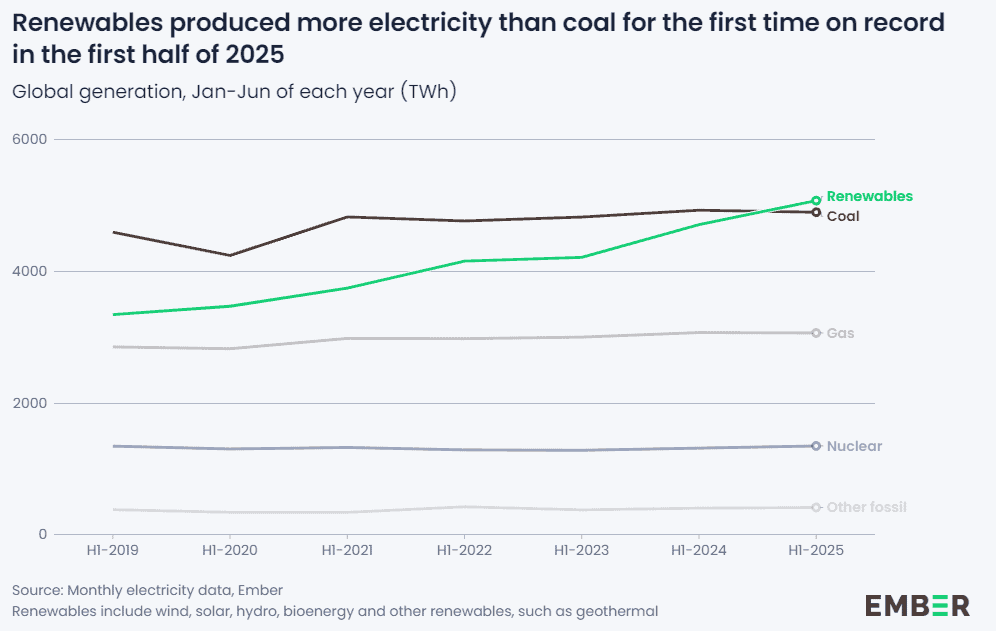For the first time in history, clean energy has outshone coal. In the first half of 2025, renewables led by solar and wind generated more electricity worldwide than coal, according to new data from Ember, a global energy think tank.
“Overall — we’re talking globally — renewables overtook coal,” said Malgorzata Wiatros-Motyka, a senior electricity analyst at Ember, in an interview with Grist. “And I expect this to hold.”
It’s a milestone decades in the making. Renewable sources supplied 34.3% of the world’s electricity between January and June 2025, while coal slipped to 33.1%, Ember found. For an energy system that’s been hooked on fossil fuels since the Industrial Revolution, this is nothing short of revolutionary.
A Crucial Turning Point
Ember calls this a “crucial turning point.” The growth of solar and wind didn’t just meet rising global electricity demand — it exceeded it, leading to a slight decline in fossil fuel use for the first time.
Solar power did most of the heavy lifting, providing a staggering 83% of the increase in electricity demand, and it’s now been the largest source of new electricity worldwide for three consecutive years.
“The moment marks the beginning of a shift where clean power is keeping pace with demand growth,” Wiatros-Motyka told the BBC.
That’s partly thanks to the wild plummet in solar prices. Since 1975, the cost of solar power has fallen by 99.9%. Many of the fastest adopters are in the Global South. Nearly 58% of global solar generation now comes from lower-income countries.
Pakistan imported enough panels in 2024 to generate 17 gigawatts of solar power — double the previous year, and roughly one-third of the country’s total electricity capacity. Across Africa, solar imports rose 60%, led by South Africa, Nigeria, and Algeria.
In China, clean energy growth is so ferocious, frankly, it sounds ridiculous. The country added more solar and wind capacity than the rest of the world combined, Ember found, pushing fossil fuel generation down 2%. China now accounts for 55% of global solar growth.
And this transformation is paying off in more ways than one. As Wiatros-Motyka told NPR, the shift toward renewables gives countries greater independence from imported fuel. “There has been more investment in infrastructure that facilitates clean growth [in emerging economies] than in many advanced economies,” she said. “This is probably about some countries missing the opportunities, and maybe they don’t realize it, but that’s what it is.”
The U.S. Slows Down, But the World Speeds Up
While developing nations are racing ahead, richer economies are faltering. In the United States, coal-fired power generation rose 17% in early 2025, and the International Energy Agency (IEA) has halved its forecast for U.S. renewable growth this decade, from 500 gigawatts to 250.
Congress voted in July to phase out long-standing tax credits for wind and solar, and the Trump administration has moved to halt or delay dozens of renewable projects. But even a Trump administration that bears an almost visceral hate for wind turbines and solar panels can do little to stop the inevitable.
“They can slow it down; they can do a lot more damage than I thought they could,” said Robert Brecha, a senior adviser at Climate Analytics. “But they can’t stop it.”
In Europe, poor weather rather than politics dimmed the outlook. Months of weak wind and drought shrank the continent’s renewable output, forcing a 14% rise in gas-fired generation.
Even so, the global story is clear: coal’s dominance is ending. The IEA still lists coal as the single largest individual energy source, but its share is shrinking fast.
China’s Solar Royalty and the AI Energy Crunch
China is the epicenter of renewable growth. China manufactures a vast majority of the world’s solar panels, accounting for around 80% of global production. In the first half of 2023, China’s solar module exports alone were 114 GW, a 34% increase from the previous year. As Daniel Cohan, a civil and environmental engineer at Rice University, told NPR, “China took technologies that were originally developed in the United States back in Bell Labs in the 1950s and figured out how to scale them up.”
The result is a clean tech manufacturing empire, which extends to other verticals besides solar. In August 2025 alone, China’s clean tech exports hit a record $20 billion, with surging sales of electric vehicles and batteries.
Meanwhile, the U.S. is facing a new kind of problem barely anyone anticipated just ten years ago: energy-hungry data.
“This has really been an inflection point for the United States,” Cohan said. “With the growth of data centers, and AI and crypto, and other growth from industries and air conditioning, we’re starting to see electricity demand grow 3% per year, rather than be flat or 1%.”
AI data centers — those massive warehouses of servers that feed machine learning — are forcing utilities to scramble for new generation sources, often defaulting back to gas and coal when renewables can’t scale fast enough.
“It’s a question of whether this wind and solar that we’re adding is able to keep pace with the demand growth,” Cohan added. “If wind and solar don’t grow fast enough, that means we have to keep running the gas and coal power plants that we already have a little bit harder than before.”




